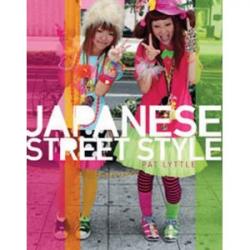Japanese Street Style

By Pat Lyttle, Bloomsbury/A&C Black, 2012, 128 pages, ISBN 978-1-4081-5671-1, £19.99
Review by Ali Muskett
Japanese Street Style claims to be ‘the first book of its kind to showcase the most innovative and cutting-edge looks in Japan today.’ There certainly does seem to have been a gap in the market since Fruits and Fresh Fruits (Shoichi Aoki, Phaidon, 2001 & 2005), although many fans of Japanese street fashion would probably rather fill that gap with the latest fashion magazines and websites, rather than fork out £19.99 for a book of glossy photographs. That said, Japanese Street Style is a gorgeous, colourful book, which would certainly brighten up any fashion-fan’s Muji coffee table.
The photographer, Pat Lyttle, started out as a chef specialising in Japanese cuisine, but soon realised he was more at home in the world of fashion. Although untrained as a photographer, he has photographed some of the biggest celebrity names, including Betty Davis and Joan Collins. Now Lyttle focuses on fashion, in particular Japanese street fashion, and has a website and blog called JStreetstyle.
The majority of the pages of Japanese Street Style are taken up with pictures of young Japanese people posing in the latest street fashion trends. Poses range from sultry and pouty, to happy-go-lucky and leaping in the air. Many are making peace-signs with their fingers – I counted at least 32 peace-signs throughout the book – and this does become a little wearying. I suppose it’s just a reflection of Japanese street style and youth culture though, and I don’t blame the photographer for this lack of creativity.
The fashion tribes and trends which the book covers include: Lolita (Classical, Gothic, Elegant, Punk, Sweet, Guro and Male), Dolly Kei, Kogal or Kogyaru, Ganguro, Date Megane, Kigurumi, Visual Kei, and Decora. Brief explanations of the styles are included at the beginning of the book, although the pictures beside them don’t seem to match up, and aren’t labelled. It would have been nice to have included a small example picture with each explanation – this is a photo book, after all.
Pat Lyttle is an excellent fashion photographer, and manages to convey the spirit of his subjects’ characters in his pictures. These young people are bursting with life and energy, and generally look thrilled to be photographed. Lyttle believes that, ‘Style is an expression of one’s feelings – how you feel and how you choose to display those feelings visually,’ and certainly captures that essence in his photographs. In the book’s introduction he also notes that, ‘In Japanese society individuality has traditionally been viewed as less of a positive thing while the group identity is strongly encouraged. […] But in Tokyo or Osaka you’ll find possibly the largest concentration of individual style on the planet, a unique teenage culture of individual self-expression that seeks neither understanding nor approval, but just to be itself.’ Japan is a country which lives by the expression ‘The nail that sticks up will be hammered down’ (出る釘は打たれる), so some people might be surprised to see the wild fashion trends that are becoming popular among young people in Japan today. Seeing the creativity in some of these outfits – not just wearing a dress off-the-rack, but adapting and customising it to express something – makes me think we should be paying more attention to the youth of Japan, because they obviously have something to say.
While I simply can’t fault the photos in Japanese Street Style, I found that the captions beside them didn’t always adequately explain what fashion trend I was looking at. This led me to wonder what the exact purpose of this book is – should I be learning something about street fashion, or simply lusting after gorgeous clothes, accessories and shoes (oh my, the shoes!). If it’s the latter, then bravo Pat Lyttle. However, if it’s the former, I did find the text lacking in places. Some captions describe the outfits worn, including fashion brands and even the names of the models, whereas other photos are completely captionless, or include captions with odd little bits of rhyme that I found wholly unnecessary and grating (‘Four girls from Ame Mura lined up in a row. Dressed in so many colours from their head to their toes’).
Throughout the book, the quality of the writing simply doesn’t match the quality of the photographs. Lyttle writes enthusiastically, showing his passion for Japanese street style, but his words seem to be based more on opinion than research. In addition, the editing and proof-reading throughout the book are, quite frankly, sloppy. At the beginning of the book the blurb about Punk Lolita appears on two different pages, containing different information. Later in the book, two captions have been switched, so that the description of two Lolitas in the brand Baby the Stars Shine Bright sits beside an image of two Visual Kei girls splattered in red paint. I had a sense of dejavu when I realised that one picture of some pretty pink rose shoes was repeated on two separate pages. As gorgeous as the shoes were, I didn’t need to see them twice. And then there’s the reference to Dolly Kei ‘Taking its visual queue [sic] from Eastern European folklore and fairytales.’
All in all, Japanese Street Style is a bright, fun book containing interesting, beautifully shot photographs full of character and energy. But, if you’re looking for a place to learn about Japanese street style and fashion, I wouldn’t rely on this book.

